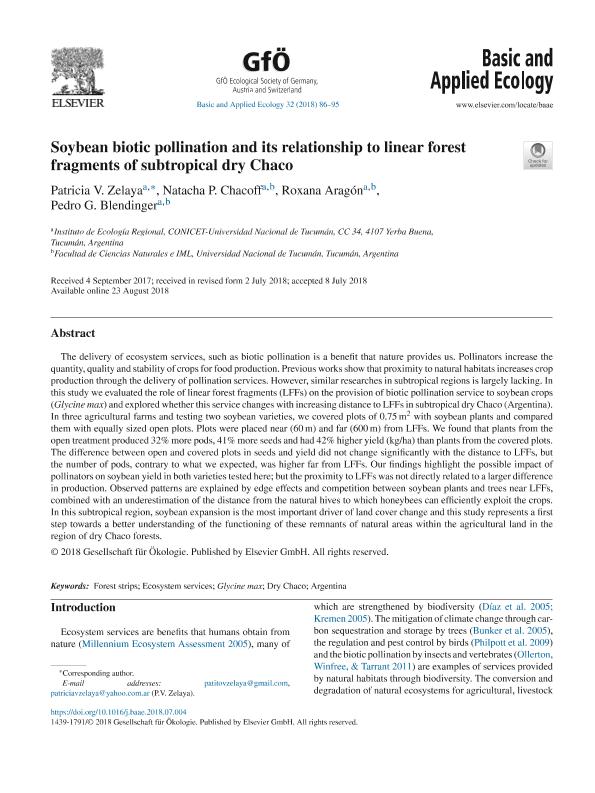Mostrar el registro sencillo del ítem
dc.contributor.author
Zelaya, Patricia Viviana

dc.contributor.author
Chacoff, Natacha Paola

dc.contributor.author
Aragón, Myriam Roxana

dc.contributor.author
Blendinger, Pedro Gerardo

dc.date.available
2019-11-25T23:23:34Z
dc.date.issued
2018-11
dc.identifier.citation
Zelaya, Patricia Viviana; Chacoff, Natacha Paola; Aragón, Myriam Roxana; Blendinger, Pedro Gerardo; Soybean biotic pollination and its relationship to linear forest fragments of subtropical dry Chaco; Elsevier Gmbh, Urban & Fischer Verlag; Basic and Applied Ecology; 32; 11-2018; 86-95
dc.identifier.issn
1439-1791
dc.identifier.uri
http://hdl.handle.net/11336/90417
dc.description.abstract
The delivery of ecosystem services, such as biotic pollination is a benefit that nature provides us. Pollinators increase the quantity, quality and stability of crops for food production. Previous works show that proximity to natural habitats increases crop production through the delivery of pollination services. However, similar researches in subtropical regions is largely lacking. In this study we evaluated the role of linear forest fragments (LFFs) on the provision of biotic pollination service to soybean crops (Glycine max) and explored whether this service changes with increasing distance to LFFs in subtropical dry Chaco (Argentina). In three agricultural farms and testing two soybean varieties, we covered plots of 0.75 m2 with soybean plants and compared them with equally sized open plots. Plots were placed near (60 m) and far (600 m) from LFFs. We found that plants from the open treatment produced 32% more pods, 41% more seeds and had 42% higher yield (kg/ha) than plants from the covered plots. The difference between open and covered plots in seeds and yield did not change significantly with the distance to LFFs, but the number of pods, contrary to what we expected, was higher far from LFFs. Our findings highlight the possible impact of pollinators on soybean yield in both varieties tested here; but the proximity to LFFs was not directly related to a larger difference in production. Observed patterns are explained by edge effects and competition between soybean plants and trees near LFFs, combined with an underestimation of the distance from the natural hives to which honeybees can efficiently exploit the crops. In this subtropical region, soybean expansion is the most important driver of land cover change and this study represents a first step towards a better understanding of the functioning of these remnants of natural areas within the agricultural land in the region of dry Chaco forests.
dc.format
application/pdf
dc.language.iso
eng
dc.publisher
Elsevier Gmbh, Urban & Fischer Verlag

dc.rights
info:eu-repo/semantics/openAccess
dc.rights.uri
https://creativecommons.org/licenses/by-nc-sa/2.5/ar/
dc.subject
ARGENTINA
dc.subject
DRY CHACO
dc.subject
ECOSYSTEM SERVICES
dc.subject
FOREST STRIPS
dc.subject
GLYCINE MAX
dc.subject.classification
Ecología

dc.subject.classification
Ciencias Biológicas

dc.subject.classification
CIENCIAS NATURALES Y EXACTAS

dc.title
Soybean biotic pollination and its relationship to linear forest fragments of subtropical dry Chaco
dc.type
info:eu-repo/semantics/article
dc.type
info:ar-repo/semantics/artículo
dc.type
info:eu-repo/semantics/publishedVersion
dc.date.updated
2019-10-16T20:56:56Z
dc.journal.volume
32
dc.journal.pagination
86-95
dc.journal.pais
Alemania

dc.journal.ciudad
Berlín
dc.description.fil
Fil: Zelaya, Patricia Viviana. Universidad Nacional de Tucumán. Instituto de Ecología Regional. Consejo Nacional de Investigaciones Científicas y Técnicas. Centro Científico Tecnológico Conicet - Tucumán. Instituto de Ecología Regional; Argentina
dc.description.fil
Fil: Chacoff, Natacha Paola. Universidad Nacional de Tucumán. Instituto de Ecología Regional. Consejo Nacional de Investigaciones Científicas y Técnicas. Centro Científico Tecnológico Conicet - Tucumán. Instituto de Ecología Regional; Argentina. Universidad Nacional de Tucumán. Facultad de Ciencias Naturales e Instituto Miguel Lillo; Argentina
dc.description.fil
Fil: Aragón, Myriam Roxana. Universidad Nacional de Tucumán. Instituto de Ecología Regional. Consejo Nacional de Investigaciones Científicas y Técnicas. Centro Científico Tecnológico Conicet - Tucumán. Instituto de Ecología Regional; Argentina. Universidad Nacional de Tucumán. Facultad de Ciencias Naturales e Instituto Miguel Lillo; Argentina
dc.description.fil
Fil: Blendinger, Pedro Gerardo. Universidad Nacional de Tucumán. Instituto de Ecología Regional. Consejo Nacional de Investigaciones Científicas y Técnicas. Centro Científico Tecnológico Conicet - Tucumán. Instituto de Ecología Regional; Argentina. Universidad Nacional de Tucumán. Facultad de Ciencias Naturales e Instituto Miguel Lillo; Argentina
dc.journal.title
Basic and Applied Ecology

dc.relation.alternativeid
info:eu-repo/semantics/altIdentifier/url/https://www.sciencedirect.com/science/article/pii/S1439179117302852
dc.relation.alternativeid
info:eu-repo/semantics/altIdentifier/doi/http://dx.doi.org/10.1016/j.baae.2018.07.004
Archivos asociados
